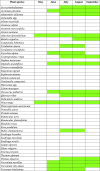Plants' healthiness assessment as part of the environmental monitoring of protected mountainous area in the example of Karkonosze (Giant) Mts. (SW Poland)
- PMID: 27590881
- PMCID: PMC5010597
- DOI: 10.1007/s10661-016-5551-5
Plants' healthiness assessment as part of the environmental monitoring of protected mountainous area in the example of Karkonosze (Giant) Mts. (SW Poland)
Abstract
The aim of phytopathological monitoring is to check the healthiness of plants and observe the changes that occur in their populations. In the vast majority, these types of observations are conducted in agriculture and forestry. An interesting aspect of phytopathological monitoring is the assessment of the origin of the plant species. The research of fungal communities (including pathogens) in plants may, for example, indicate the relic nature of the plant species. Reduction of the occurrence or disappearance of fungi species associated with its host plant can evidence slow decline of their habitats. This applies mainly to arctic-alpine fungal species. On the other hand, for some plant hosts, colonization of their organs by polyphagous fungi is being recorded. One such example is the downy willow, on which six species of fungi were found in the Karkonosze Mts. In 2014, there were no fungi found on this plant. However, comparing the species composition of fungi associated with downy willow given by Schroeter (1908) to the contemporary one and to the study results of other researchers, a decrease in the number of fungi species is clearly visible. This may be related to the environmental pollution, which took place in the Sudetes in the second half of the twentieth century. For instance, the species of the genus Rhytisma colonize the leaves of trees and shrubs and are particularly sensitive to the concentration of SO2 in the air, but nobody has looked for this fungus on this host in the past. Yet, presently, we were able to find Rhytisma fungus in Karkonosze Mts. Phytopathological monitoring was conducted in the years of 2014-2015 in the sub-alpine zone of the Karkonosze (Giant) Mts. It has been shown that, compared to similar studies conducted in the 1990s of the twentieth century, the species composition of fungi infesting Rubus chamaemorus and Betula carpactica has changed. Is this the beginning of changes that will occur in populations of plants?
Keywords: Environmental monitoring; Fungal diseases; Pathogenic fungi; Plant diseases.
Figures



References
-
- Alsos IG, Muller E, Eidesen PB. Germinating seeds or bubils in 87 of 113 tested Arctic species indicating potential for ex situ seed bank storage. Polar Biology. 2013;36:819–830. doi: 10.1007/s00300-013-1307-7. - DOI
-
- Bilz M, Kell S, Maxted N, Lansdown R. European red list of vascular plants. Luxembourg: Publication Office of the European Union; 2011.
-
- Borowicz V. Do arbuscular mycorrhizal fungi alter plant–pathogen relations? Ecology. 2001;82(11):3057–3068.
-
- Chlebicki A (1997) Microfungi on Carex magellanica Lam. ssp. Irrigua and Juncus trifidus L. from Karkonosze (Giant) Mts. Geoekologiczne Problemy Karkonoszy. Proceedings from Scientific Workshops in Przesieka 15–18.10.1997: 313–316 (in Polish with English summary)
MeSH terms
LinkOut - more resources
Full Text Sources
Other Literature Sources
Medical
Miscellaneous

